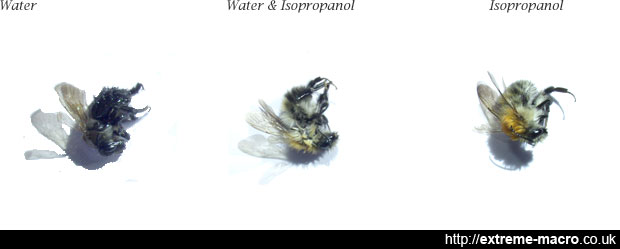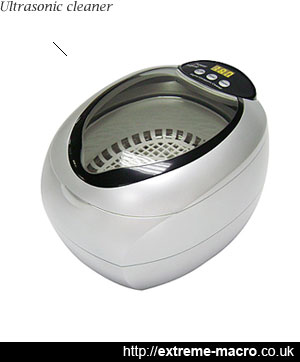Drying Insects
by Johan J Ingles-Le Nobel
Last updated August 31, 2017
The problem is this: you've washed your insect specimen and you're itching to start a stack before the eyes start to deteriorate, but it's wet. So how do you dry your insect quickly to be able to start your focus stack?
Isopropanol To The Rescue
the Isopropanol is displacing the hydrogen bonds in the smallest of gaps, akin to adding water to a bucket filled with marblesAs a biological specimen preservative, Isopropanol (IPA) provides a comparatively non-toxic alternative to formaldehyde and other preservatives. Isopropanol is one of the standard chemicals used to preserve specimens, and also used in DNA extraction. Isopropanol is relatively easy to obtain at high levels of purities, and can easily be bought by the litre in Maplins in the UK. Isopropanol is a standard tool in the entomologist's tool bag but it also has another cool use in scientific macro photography: drying out dead specimens, fast.
When you wash your insect specimen using soapy water in an ultrasonic cleaner, your specimen will take in molecules of water and become waterlogged. This means that to dry out your specimen we need some way to drive these water molecules out from wherever they have become lodged, be they on the outside of the exoskeleton or absorbed into other small spaces.
Consumer model ultrasonic bath, usually used for jewellery but convenient for cleaning insect specimens. But after you've cleaned you specimen beautifully, you'll want to dry it to take a photograph and this is where Isopropanol comes to the rescue.
In these small spaces, water molecules stick together because water molecules are polar (for example raindrops). Polar molecules have a permanent positive region and negative region on them. They stick to each other because opposite charges attract. Water has a special type of polar attraction for itself which is especially strong and gets the term hydrogen bond.
Each water molecule has four sites where hydrogen bonding can occur: one on each hydrogen and the two lone pairs of electrons on the oxygen. Isopropanol has fewer sites for hydrogen bonding to occur. This is because of the two methyl regions on the molecule that prevent the O - H hydrogen bond to form. Mixing the two, Isopropanol and water, means hydrogen -bonds between Isopropanol and water occur that evaporate more readily because the hydrogen bonding is weaker in Isopropanol (ie it is volatile - evaporates fast).
Faster Drying
For faster drying, these Isopropanol phenomena come to the rescue. Take your washed specimen out of the water (if they're still floating that's good, it means they haven't absorbed too much water through the exoskeleton and the water is just clinging to the outside), rinse and agitate it thoroughly a few times with fresh solutions to get rid of the detergent, then dunk it in a testube or specimen tube of Isopropanol, and it should sink to the bottom.
Specimen Preparation Walkthrough
1 ➤ The specimen preparation workflow
2 ➤ How to clean preserved specimens
3 ➤ How to relax specimens for spreading
4 ➤ How to make spread specimens for setting
5 ➤ How to cure dehydrated eyes
6 ➤ How to dry a cured specimen fast
7a ➤ How to pin a cured specimen, or...
7b ➤ How to card a cured specimen
Other reading: focus stacking walkthrough
Swirl it about for a few seconds and then let it sit in that, swishing it occasionally and/or tapping the tube. What's happening during this time is quite magical and invisible, but the Isopropanol is displacing the hydrogen bonds in the smallest of gaps, akin to adding water to a bucket filled with marbles. Then, after letting it sit in IPA for a few minutes, give it a final good shake, and remove from Isopropanol and let the specimen dry. The Isopropanol has displaced the water hydrogen bonds but because it's volatile it evaporates quickly, which water doesn't. You could also try methanol which has an even lower boiling point (ie is more volatile), but beware there are impurities in methanol like oil that might leave a residue. Methanol can be purchased via remote control model aircraft shops.

Isopropanol testing. The bee on the left was in water for 15 mins, the bee in the middle in water for 10 mins then Isopropanol for 5 mins and the control bee on the right just Isopropanol for 15 mins, all removed at the same time, allowed to just air dry (the Isopropanol evaporates). This is c.20 minutes after removing them - the bee on the left is still wet but both the middle and the right are dry, ready to be photographed. There are still pilosity issues though, but there is no known answer to these other than a subsequent soak in ethyl acetate which only partially helps.
Further Insect Drying Techniques
The next thing to consider would be to aid the fluffyness of your insect, and in this a hair drier or a small computer fans are invaluable. With a hairdryer set on low heat you can put your insect in a container with fine gauze, and blow hot air into it for 5 mins or so. This will dry your insect nicely and ameliorate pilosity issues by giving it fluffyness as well, for example bumblebee hairs come out nicely like this. You might think that limbs and appendages would fall off and although some will, you'd be surprised how tough insect parts are. Just be careful though of the antennae, they do have a tendency to snap once they're dry and brittle. If you're feeling creative, you could always try building yourself a bee autodrier, and use a stream of hot air to keep the insect floating in air and thus prevent breakages.
With a hairdryer set on low heat you can put your insect in a container with fine gauze, and blow hot air into it for 5 mins or soIf you're prepared to wait a little longer you can always build yourself an insect drying cupboard, much beloved by entomologists. A home-made drying cupboard consists of a modified bedroom cabinet, lined with cooking foil, containing a wardrobe heater. The thing about this though is that eyes do start to deteriorate quickly, so for extreme macro quicker is generally better. Drying cabinets can also be made out of plywood and look very straightforward. Just a couple of 40 watt bulbs in the bottom, thin strips for lattice shelving, and you have a multipurpose cabinet for drying all your material. Don't forget to allow enough space between the shelves for your board plus pin height in case you want to pin as well, and drill some small holes in the top of the box for airflow. You can be quite creative and also use a dehumidifier and silica gel to absorb moisture as well, or make a contraptions that combines all methods.
Interesting Aside
Isopropanol is pretty awesome stuff - it doesn't just displace water in insects, it also works for electronics. You can fix rained-on broken flashes and waterlogged cellphones and iphones with it as well. It even helps cameras (try at your own risk!)
Related Articles





